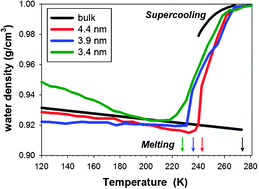Density minimum of confined water at low temperatures: a combined study by small-angle scattering of X-rays and neutrons
Abstract
A simple explanation is given for the low-temperature density minimum of

* Corresponding authors
a
Montanuniversitaet Leoben, Institute of Physics, Franz-Josef-Strasse 18, 8700 Leoben, Austria
E-mail:
oskar.paris@unileoben.ac.at
b Helmholtz Center Berlin for Materials and Energy, Hahn-Meitner-Platz 1, 14109 Berlin, Germany
c Helmholtz Center Berlin for Materials and Energy, Albert-Einstein-Str. 15, 12489 Berlin, Gemany
A simple explanation is given for the low-temperature density minimum of

 Please wait while we load your content...
Something went wrong. Try again?
Please wait while we load your content...
Something went wrong. Try again?
M. Erko, D. Wallacher, A. Hoell, T. Hauß, I. Zizak and O. Paris, Phys. Chem. Chem. Phys., 2012, 14, 3852 DOI: 10.1039/C2CP24075K
To request permission to reproduce material from this article, please go to the Copyright Clearance Center request page.
If you are an author contributing to an RSC publication, you do not need to request permission provided correct acknowledgement is given.
If you are the author of this article, you do not need to request permission to reproduce figures and diagrams provided correct acknowledgement is given. If you want to reproduce the whole article in a third-party publication (excluding your thesis/dissertation for which permission is not required) please go to the Copyright Clearance Center request page.
Read more about how to correctly acknowledge RSC content.
 Fetching data from CrossRef.
Fetching data from CrossRef.
This may take some time to load.
Loading related content
